

Being from Rio myself, I’ll be the first to tell you: it’s a city that refuses to make sense, but somehow, everything clicks. The views are stunning, yes, but what really defines Rio is the rhythm of daily life: becoming best friends with someone you just met at the bar, the energy of a roda de samba, people gathering to watch the sunset at Arpoador, the drums, whistles and colours of a street carnival….
Among cariocas (locals), we say Rio is the city of beauty and chaos. And once you find your way through the beautiful mess, it will be difficult to ever want to leave.
If you’re trying to figure out how to navigate all of it, stick with me. I’ll break down what you’ll spend to live in Rio like a true carioca, chaos and all.
Renting in Rio is full of contrasts. One street might have stunning ocean views, while the next winds up a steep cobblestone alley. Prices swing all over the place depending on the neighbourhood, the building, and how close you are to the beach.
And here’s a little secret many newcomers miss: the rent you see isn’t the full story. You’ll also need to cover the condomínio (building maintenance fee) and IPTU (property tax), which can tack on $100 to $350 a month depending on the building’s age, location, and perks.
I’ll break down rent and living costs across the neighbourhoods I recommend most for expats, so you can find the perfect spot to call home in Rio.
Ipanema (South Zone)
This is beach life at its finest: steps from the sand, surrounded by trendy cafés, designer stores, and a crowd that loves to see and be seen. It’s safe, upscale, and perfectly blends surf and city energy.
Most rentals here are modern apartments with balconies and ocean views, often inside stylish buildings with doormen and amenities. If you want that postcard-perfect Rio life, this is it… but it doesn’t come cheap.
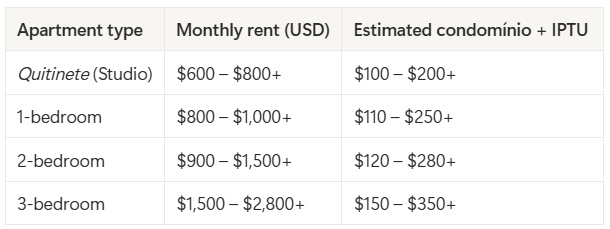
Leblon (South Zone)
If Ipanema is lively and social, I’d say Leblon is the elegant older sister. Calmer streets, fancy cafés, and a beach that feels a little more private.
Most rentals here are modern apartments with great amenities, like parking, pools, and even gyms. Leblon is the one if you want a quieter version of Rio’s beach life with a luxury touch. However, it is the most expensive neighbourhood in the city.
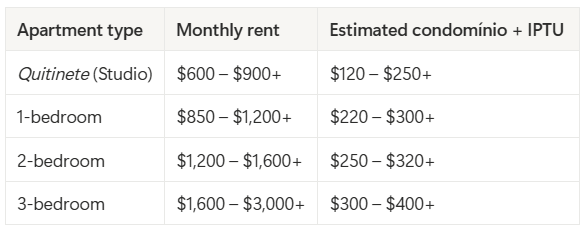
Copacabana (South Zone)
Copa is the most touristy and famous bairro (neighbourhood). It’s packed, loud, and a little messy, but it’s hard not to love it. You’ll find locals, tourists, and lifelong residents all sharing the same (huge) stretch of sand.
Most rentals in Copacabana are older apartments in classic buildings. You can find some with small balconies or sea views if you’re lucky. It’s not the calmest area, but you can live on or around the beach for a lot less than in Ipanema or Leblon.

Botafogo (South Zone)
Botafogo has that perfect in-between vibe, with city energy that's not too chaotic. You’ve got views of the Sugarloaf Mountain, great cafés, and quick access to both the beaches and the metro. It’s where many people settle when they want to be close to everything.
It features a mix of modern apartments and older ones, well-structured buildings, and everything you need within walking distance.

Flamengo (South Zone)
This is one of my favourites. I feel like Flamengo is cool without trying. It’s residential, calm, and full of leafy streets, but you’re still just a few metro stops away from downtown or the beach. The Flamengo Park (Aterro do Flamengo) is basically everyone’s backyard here. It’s perfect for morning runs, weekend picnics, or just people-watching by the bay.
You’ll find plenty of classic Rio apartments with high ceilings and vintage tiles, and the rent is usually friendlier than in the beach zones. It’s great if you want a quieter base with quick access to the city buzz.

Santa Teresa (Central)
Santa Teresa is Rio’s bohemian soul. It’s slower, artsier, and full of charm. You'll find colourful colonial houses turned into art studios, charming guesthouses, and vintage-style flats with city views. Most rentals here are older homes full of personality, high ceilings, tiled floors, and balconies.
It’s not the easiest place to move around, but if you love charm over convenience, this hilltop neighbourhood will win you over fast.

Glória/Catete (Central)
Glória and Catete sit right between the beach zones and downtown. They’re super central, full of life, and packed with history. You’ll find old apartments with tall windows, wooden floors, and those classic tiled hallways that feel very Rio Antigo (old Rio).
It’s perfect if you want easy access to everything without paying Zona Sul (South Zone) prices. Plus, you’re a short walk from Flamengo Park and the metro, which makes it easier to get anywhere in the city.
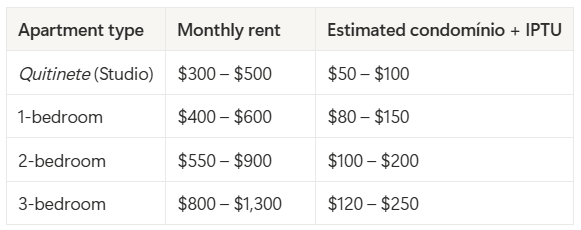
Barra da Tijuca (West Zone)
Barra feels like a whole different city, with wide streets, modern high-rises, shopping malls, and endless beaches. Most rentals here are inside condomínios (gated communities) with pools, gyms, and 24-hour security, so it’s great if you like comfort and space.
It’s a bit far from the city centre, but if you drive or don’t mind longer commutes, you’ll like the calm vibe, surf spots, and the feeling of living in a little urban resort.
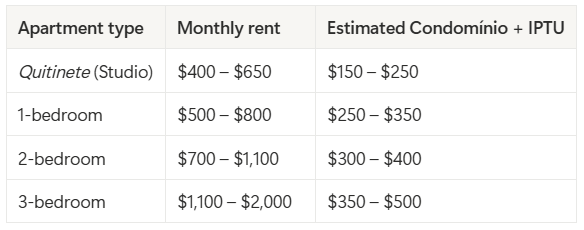
Tijuca (North Zone)
Tijuca is one of Rio’s most traditional neighbourhoods. It’s right by the North Zone and well connected to the metro, making it easy to reach the city centre or the South Zone (beach areas). The neighbourhood has a strong local feel: you’ll find family-owned bakeries, lively markets, and streets full of life.
Housing here ranges from older apartments to more modern buildings with amenities. It’s a great option if you want an authentic Rio experience without the high prices of the beachside areas.
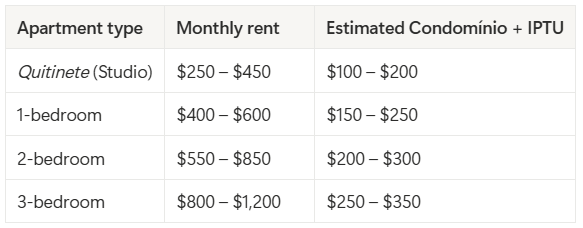
Grajaú (North Zone)
Grajaú is a hidden gem tucked away in the North Zone. It’s quiet, leafy, and one of those neighbourhoods where people still greet each other on the street and kids play outside. The pace is slower here, but you’re still close to Tijuca and the metro, so you can easily reach other parts of the city.
Rent is generally more affordable than in Tijuca or the South Zone, and you’ll find larger apartments or even small houses for the same price you’d pay for a one-bedroom elsewhere. It’s ideal if you’re after space, peace, and a bit of that small-town vibe within Rio, away from tourist traps.

Rio is a city of hills, beaches, and busy streets. Getting around is just part of the adventure, and expats have a few main options, each with its pros and cons.
Metro
The metro is fast, safe, and reliable for connecting key areas like Centro, Botafogo, Flamengo, Copacabana, Ipanema, and Leblon. Trains run roughly every 4–6 minutes during peak hours.
Buses
Buses cover almost every corner of the city, but they can be slow in traffic. Some routes are safe and comfortable; others, especially in tourist-heavy areas or at night, are less recommended.
Uber/99
Ride-hailing apps are the most used here. They’re often safer and more convenient than taxis.
Car rentals / driving
Driving in Rio is possible but challenging: traffic is heavy, parking is expensive, and streets can be steep and confusing. It’s great if you plan trips outside the city or want flexibility in Barra da Tijuca.
Cycling
It’s also possible to rent bikes in Rio, which is a fun and healthy way to get around, especially along the beaches and in areas with bike lanes like Aterro do Flamengo or parts of Copacabana and Ipanema. Many apps let you locate and unlock bikes on the go.
Here is a breakdown to make it easier:

Pro tip for expats: As locals, we combine transport modes: metro for fast, long trips, Uber for late-night rides, and walking for neighbourhood errands. If you live in Barra, you’ll likely rely more on Uber or a car; in Zona Sul, walking and public transit cover most daily needs.
Food in Rio is a whole vibe. You can grab a quick snack by the beach, dig into a feijoada, or hunt for exotic ingredients for your own kitchen. There’s something for every taste and budget.
Restaurants
If you’re just starting out, there are plenty of casual spots where you can grab a salgadinho (savoury snack) or a sandwich for $3–8. Lunch at a local boteco (bar/restaurant) will run around $6–12, and it’s often the perfect excuse to sit, sip a juice or beer, and watch the city move.
For a sit-down meal with friends, expect to spend $15–25 per person. You'll get grilled meats, fresh seafood, or the classic PF (prato feito, a full lunch plate with rice, beans, salad, and meat).
If you’re feeling fancy or celebrating something, Rio’s fine dining scene is amazing. A meal for two can easily hit $80–150, with cocktails adding a few more dollars. But the food and vibe are totally worth it.
Supermarkets
Now, grocery shopping in Rio is a story on its own. The city has everything from high-end boutique-style stores to budget-friendly local markets. Here’s the rundown:

Tip: I usually mix it up. Guanabara or Mundial for the basics, and Zona Sul or Pão de Açúcar when I want a treat or something special for dinner. Also, grocery prices can vary a bit depending on where you live. In Ipanema or Leblon, expect higher prices for the same items, especially at premium stores. Botafogo, Flamengo, and Glória/Catete have mid-range options like Guanabara, while Copacabana and Barra offer a mix. You can find bargains at Mundial or Extra if you know where to look.
Here’s a realistic monthly breakdown in USD:
For one person
Total monthly food budget: $520–800
This gives you a mix of cooking at home, weekend brunches, and a few nights out without feeling restricted.
For a couple or small family
Total monthly food budget: $1,000–1,480
Enough for regular grocery shopping, occasional fine dining, and still exploring Rio’s countless food options.
Living in Rio comes with the usual utility costs, but there are a few local quirks to keep in mind. Here’s what you can expect as an expat:
Electricity
Electricity can be surprisingly pricey, especially if you use air conditioning, which, honestly, is a must if you want to survive Rio’s summer.
Water and sewer
Water bills are usually affordable, but they’re often combined with sewer fees.
Gas
Most apartments use piped gas for cooking and water heating, which is included in your condo or building fees in many cases.
Internet and TV
High-speed internet is widely available, and we usually combine it with streaming services rather than traditional cable.
Mobile/Cell phone
Mobile plans in Rio are flexible, often prepaid (pré-pago) or postpaid (pós-pago).

Healthcare in Rio is a mix of public access, private comfort, and everything in between. You’ll find excellent doctors and modern hospitals, but the experience (and cost) depends a lot on whether you’re using the public system (SUS) or private care.
Public healthcare (SUS)
Brazil’s Sistema Único de Saúde (SUS) is free and available to everyone, from locals and expats to tourists in emergencies. The system covers general consultations, hospital stays, and medications for chronic conditions.
If you live in Rio long-term and speak some Portuguese, you can rely on SUS for routine care, but most expats prefer private hospitals for faster service and English-speaking doctors.
Private health insurance
If you plan to stay for a while, private health insurance (plano de saúde) is worth considering. Plans vary from basic outpatient coverage to full hospital and dental care. The biggest providers are Bradesco Saúde, SulAmérica, Unimed, and Amil.

Tip: Expats often choose a mid-tier plan and pay out of pocket for minor visits. A basic consultation at a private clinic without insurance costs around $30–60, while a specialist (like a dermatologist or orthopaedist) can range from $60–120.
Rio is one of Brazil’s priciest cities. Between rent, transport, and the occasional caipirinha by the beach, costs add up quickly.
That said, it can still fit different lifestyles. Here’s what your monthly budget might look like:

In the end, you can live comfortably on around $1,500/month, but to fully enjoy the carioca lifestyle without cutting corners, $2,000–2,500/month is a realistic sweet spot for most expats.
I’ve lived in a few countries before, sending money back home and figuring out how to make different currencies work. Now I’m back in Rio, earning in dollars and spending in reais, so believe me: I know the pain. Watching exchange rates, paying fees, and waiting for transfers just turn a simple purchase into endless headaches.
Grey makes that part simple. You can send money abroad, receive your salary in USD, GBP, or EUR, and withdraw in reais when rates are good, all without the stress of conversions or hidden fees.
Open your Grey account today and manage your money the easy way, so you can focus on enjoying Rio's beauty, embracing the chaos, and making the city your own.




.svg)
Back to top